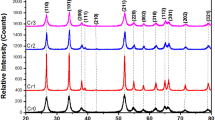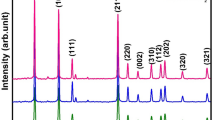Abstract
In this work, cerium dioxide nano-particles (CeO2-NPs) were deposited by chemical electroless deposition process on silicon nanowires (Si-NWs) elaborated by metal-assisted chemical etching. The obtained thin films were characterized by scanning electron microscopy (SEM), energy-dispersive X-ray spectroscopy (EDX), X-ray diffraction (XRD), photoluminescence (PL), X-ray photoelectron spectrometry (XPS) and UV–Vis spectrophotometry. The Si-NWs/CeO2-NPs films were successfully applied as photocatalysts for the oxidation of Rhodamine B (Rh B), a recalcitrant dye under visible irradiation. The films showed a higher photocatalytic performance with a quasi-total discoloration within 75 min against only 67% for Si-NWs. The radical trapping tests showed that the electrons (e−), •OH, O2•− and holes (h+) are the main species involved in the Rh B degradation; a reaction mechanism was suggested and discussed. This work provides a new alternative to develop an efficient photocatalyst to eliminate emerging pollutants from the aquatic environment.







Similar content being viewed by others
References
Wang S, Chen Z, Cai Y et al (2023) Application of COFs in capture/conversion of CO2 and elimination of organic/inorganic pollutants. Environ Funct Mater. https://doi.org/10.1016/J.EFMAT.2023.03.001
Chen Z, Li Y, Cai Y et al (2023) Application of covalent organic frameworks and metal–organic frameworks nanomaterials in organic/inorganic pollutants removal from solutions through sorption-catalysis strategies. Carbon Res 21(2):1–22. https://doi.org/10.1007/S44246-023-00041-9
Cai Y, Chen Z, Wang S et al (2023) Carbon-based nanocomposites for the elimination of inorganic and organic pollutants through sorption and catalysis strategies. Sep Purif Technol 308:122862. https://doi.org/10.1016/J.SEPPUR.2022.122862
Liu X, Li Y, Chen Z et al (2023) Advanced porous nanomaterials as superior adsorbents for environmental pollutants removal from aqueous solutions. Crit Rev Environ Sci Technol. https://doi.org/10.1080/10643389.2023.2168473
Sathiyavimal S, Vasantharaj S, Shanmugavel M et al (2020) Facile synthesis and characterization of hydroxyapatite from fish bones: Photocatalytic degradation of industrial dyes (crystal violet and Congo red). Prog Org Coatings 148:105890. https://doi.org/10.1016/j.porgcoat.2020.105890
Mohd Adnan MA, Muhd Julkapli N, Amir MNI, Maamor A (2019) Effect on different TiO 2 photocatalyst supports on photodecolorization of synthetic dyes: a review. Int J Environ Sci Technol 16:547–566. https://doi.org/10.1007/s13762-018-1857-x
Li J, Liu X, Zhao G et al (2023) Piezoelectric materials and techniques for environmental pollution remediation. Sci Total Environ 869:161767. https://doi.org/10.1016/J.SCITOTENV.2023.161767
Marimuthu S, Antonisamy AJ, Malayandi S et al (2020) Silver nanoparticles in dye effluent treatment: a review on synthesis, treatment methods, mechanisms, photocatalytic degradation, toxic effects and mitigation of toxicity. J Photochem Photobiol B Biol 205:111823. https://doi.org/10.1016/j.jphotobiol.2020.111823
Rajendrachari S, Taslimi P, Karaoglanli AC et al (2021) Photocatalytic degradation of Rhodamine B (RhB) dye in waste water and enzymatic inhibition study using cauliflower shaped ZnO nanoparticles synthesized by a novel One-pot green synthesis method. Arab J Chem 14:103180. https://doi.org/10.1016/j.arabjc.2021.103180
Lu Y, Yu L, Zhang S et al (2023) Dual-functional fluorescent metal-organic framework based beads for visual detection and removal of oxytetracycline in real aqueous solution. Appl Surf Sci 625:157202. https://doi.org/10.1016/J.APSUSC.2023.157202
Sharma K, Dutta V, Sharma S et al (2019) Journal of industrial and engineering chemistry recent advances in enhanced photocatalytic activity of bismuth oxyhalides for ef fi cient photocatalysis of organic pollutants in water: a review. J Ind Eng Chem 78:1–20. https://doi.org/10.1016/j.jiec.2019.06.022
Zhu D, Zhou Q (2019) Environmental nanotechnology, monitoring & management action and mechanism of semiconductor photocatalysis on degradation of organic pollutants in water treatment: a review. Environ Nanotechnol Monit Manag 12:100255. https://doi.org/10.1016/j.enmm.2019.100255
Kusuma KB, Manju M, Ravikumar CR et al (2022) Photocatalytic degradation of methylene Blue and electrochemical sensing of paracetamol using cerium oxide nanoparticles synthesized via sonochemical route. Appl Surf Sci Adv 11:100304. https://doi.org/10.1016/j.apsadv.2022.100304
Lai C, Xu F, Zhang M et al (2021) Journal of Colloid and Interface Science Facile synthesis of CeO 2 / carbonate doped Bi 2 O 2 CO 3 Z-scheme heterojunction for improved visible-light photocatalytic performance : photodegradation of tetracycline and photocatalytic mechanism. J Colloid Interface Sci 588:283–294. https://doi.org/10.1016/j.jcis.2020.12.073
Shen Z, Zhou Y, Guo Y et al (2021) Tuning the concentration of surface/bulk oxygen vacancies in CeO2 nanorods to promote highly efficient photodegradation of organic dyes. Chin Chem Lett 32:2524–2528. https://doi.org/10.1016/J.CCLET.2021.01.044
Munawar T, Bashir A, Nadeem MS et al (2022) Core-shell CeO2@C60 hybrid serves as a dual-functional catalyst: photocatalyst for organic pollutant degradation and electrocatalyst for oxygen evolution reaction. Ceram Int. https://doi.org/10.1016/J.CERAMINT.2022.11.008
Pei LZ, Liu HD, Lin N, Yu HY (2015) Hydrothermal synthesis of cerium titanate nanorods and its application in visible light photocatalysis. Mater Res Bull 61:40–46. https://doi.org/10.1016/J.MATERRESBULL.2014.09.094
Pei H, Zhang H, Mo Z et al (2020) Highly efficient photocatalytic degradation of rhodamine B by conical graphene quantum dots/cerium oxide composite. Ceram Int 46:3827–3836. https://doi.org/10.1016/J.CERAMINT.2019.10.106
Kannan R, Kim AR, Eo SK et al (2017) Facile one-step synthesis of cerium oxide-carbon quantum dots/RGO nanohybrid catalyst and its enhanced photocatalytic activity. Ceram Int 43:3072–3079. https://doi.org/10.1016/J.CERAMINT.2016.11.116
Kavitha G, VinothKumar J, Devanesan S et al (2022) Ceria nanoparticles anchored on graphitic oxide sheets (CeO2-GOS) as an efficient catalyst for degradation of dyes and textile effluents. Environ Res 209:112750. https://doi.org/10.1016/J.ENVRES.2022.112750
Kumar S, Kumari K, Alharthi FA et al (2020) Investigations of TM (Ni, Co) doping on structural, optical and magnetic properties of CeO2 nanoparticles. Vacuum 181:109717. https://doi.org/10.1016/J.VACUUM.2020.109717
Sättele MS, Windischbacher A, Greulich K et al (2022) Hexacene on Cu(110) and Ag(110): influence of the substrate on molecular orientation and interfacial charge transfer. J Phys Chem C 126:5036–5045. https://doi.org/10.1021/ACS.JPCC.2C00081/ASSET/IMAGES/LARGE/JP2C00081_0005.JPEG
Pandit B, Sankapal BR (2019) Koinkar PM (2019) Novel chemical route for CeO2/MWCNTs composite towards highly bendable solid-state supercapacitor device. Sci Reports 91(9):1–13. https://doi.org/10.1038/s41598-019-42301-y
Xiao Y, Tan S, Wang D et al (2020) CeO2/BiOIO3 heterojunction with oxygen vacancies and Ce4+/Ce3+ redox centers synergistically enhanced photocatalytic removal heavy metal. Appl Surf Sci 530:147116. https://doi.org/10.1016/J.APSUSC.2020.147116
Zhang Q, Guo J, Li H et al (2022) ZIF-8-Induced CeO2/ZnO Nanobelts with curled edges accelerating cycling efficiency of Ce3+/Ce4+ for superior photocatalytic performance. J Electron Mater 51:1940–1945. https://doi.org/10.1007/S11664-022-09473-2/METRICS
Zhang Q, Zhao X, Duan L et al (2020) Controlling oxygen vacancies and enhanced visible light photocatalysis of CeO2/ZnO nanocomposites. J Photochem Photobiol A Chem 392:112156. https://doi.org/10.1016/J.JPHOTOCHEM.2019.112156
Hezam A, Namratha K, Drmosh QA et al (2020) CeO2 Nanostructures enriched with oxygen vacancies for photocatalytic CO2 reduction. ACS Appl Nano Mater 3:138–148. https://doi.org/10.1021/ACSANM.9B01833/SUPPL_FILE/AN9B01833_SI_001.PDF
Chen HH, Jiang ZH, Li XD, Lei XF (2019) Effect of cerium nitrate concentration on morphologies, structure and photocatalytic activities of CeO2 nanoparticles synthesized by microwave interface method. Mater Lett 257:126666. https://doi.org/10.1016/J.MATLET.2019.126666
Shehata N, Meehan K, Hudait M, Jain N (2012) Control of oxygen vacancies and Ce+3 concentrations in doped ceria nanoparticles via the selection of lanthanide element. J Nanoparticle Res 14:1–10. https://doi.org/10.1007/S11051-012-1173-1/METRICS
Lu CP, Li G, Mao J et al (2014) Bandgap, mid-gap states, and gating effects in MoS2. Nano Lett 14:4628–4633. https://doi.org/10.1021/NL501659N/SUPPL_FILE/NL501659N_SI_001.PDF
Stroyuk O, Raevskaya A, Gaponik N et al (2018) Origin of the broadband photoluminescence of pristine and Cu+/Ag+-doped Ultrasmall CdS and CdSe/CdS quantum dots. J Phys Chem C 122:10267–10277. https://doi.org/10.1021/ACS.JPCC.8B02337/SUPPL_FILE/JP8B02337_SI_001.PDF
Tiwari S, Rathore G, Patra N et al (2018) Defect mediated changes in structural, optical and photoluminescence properties of Ni substituted CeO2. Japanese J Ind Heal 8:305–306. https://doi.org/10.48550/arxiv.1807.02417
Staub F, Rau U, Kirchartz T (2018) Statistics of the auger recombination of electrons and holes via defect levels in the band gap - application to lead-halide perovskites. ACS Omega 3:8009–8016. https://doi.org/10.1021/ACSOMEGA.8B00962/ASSET/IMAGES/LARGE/AO-2018-009626_0002.JPEG
Kulkarni SK (2015) Nanotechnology: principles and practices. Nanotechnol Princ Pract. https://doi.org/10.1007/978-3-319-09171-6
Andersson DA, Simak SI, Johansson B et al (2007) Modeling of Ce O2, Ce2 O3, and Ce O2–x in the LDA+U formalism. Phys Rev B - Condens Matter Mater Phys 75:035109. https://doi.org/10.1103/PHYSREVB.75.035109/FIGURES/9/MEDIUM
Henderson MA, Perkins CL, Engelhard MH et al (2003) Redox properties of water on the oxidized and reduced surfaces of CeO2(111). Surf Sci 526:1–18. https://doi.org/10.1016/S0039-6028(02)02657-2
Aškrabić S, Dohčević-Mitrović ZD, Araújo VD et al (2013) F-centre luminescence in nanocrystalline CeO2. J Phys D Appl Phys 46:495306. https://doi.org/10.1088/0022-3727/46/49/495306
Bozetine H, Wang Q, Barras A et al (2015) Green chemistry approach for the synthesis of ZnO-carbon dots nanocomposites with good photocatalytic properties under visible light Key laboratory for liquid-solid structural evolution and processing of materials. J Colloid Interface Sci. https://doi.org/10.1016/j.jcis.2015.12.001
Krishnan A, Vishwanathan PV, Mohan AC et al (2021) Tuning of photocatalytic performance of CeO2-Fe2O3 composite by Sn-doping for the effective degradation of methlene blue (MB) and methyl orange (MO) dyes. Surf Interfaces 22:100808. https://doi.org/10.1016/J.SURFIN.2020.100808
Chu Z, Li J, Lan YP et al (2022) KCl–LiCl molten salt synthesis of LaOCl/CeO2-g-C3N4 with excellent photocatalytic-adsorbed removal performance for organic dye pollutant. Ceram Int 48:15439–15450. https://doi.org/10.1016/J.CERAMINT.2022.02.078
Su F, Li P, Huang J et al (2021) (2021) Photocatalytic degradation of organic dye and tetracycline by ternary Ag2O/AgBr–CeO2 photocatalyst under visible-light irradiation. Sci Rep 111(11):1–13. https://doi.org/10.1038/s41598-020-76997-0
Wu D, Zhang X, Liu S et al (2022) Fabrication of a Z-scheme CeO2/Bi2O4 heterojunction photocatalyst with superior visible-light responsive photocatalytic performance. J Alloys Compd 909:164671. https://doi.org/10.1016/J.JALLCOM.2022.164671
Acknowledgements
This work is financially supported by the General Direction of Scientific Research and Technological Development, Algeria (DGRSDT/MESRS). The authors thank the staff of The Semiconductor Technology Research Center for Energy (CRTSE), Algeria.
Author information
Authors and Affiliations
Corresponding author
Additional information
Publisher's Note
Springer Nature remains neutral with regard to jurisdictional claims in published maps and institutional affiliations.
Supplementary Information
Below is the link to the electronic supplementary material.
Rights and permissions
Springer Nature or its licensor (e.g. a society or other partner) holds exclusive rights to this article under a publishing agreement with the author(s) or other rightsholder(s); author self-archiving of the accepted manuscript version of this article is solely governed by the terms of such publishing agreement and applicable law.
About this article
Cite this article
Derkaoui, K., Hadjersi, T., Boukhouidem, K. et al. Facile CeO2 nanoparticles deposition on Si-nanowires: application to the rhodamine B photodegradation under visible light. Reac Kinet Mech Cat 136, 1657–1672 (2023). https://doi.org/10.1007/s11144-023-02427-7
Received:
Accepted:
Published:
Issue Date:
DOI: https://doi.org/10.1007/s11144-023-02427-7




